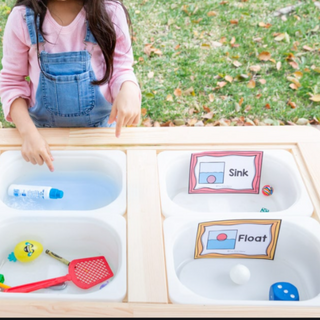
This activity is designed for 3-6-year-old children. This science activity allows children to explore the concept of sink or float.
The Objective of Sink or Float Activity
In this activity, children can play, experiment, and discover what types of objects float and sink in water and why during a hands-on activity.
Why Do Objects Sink or Float?
- Weight: The weight of an object is the measure of gravitational force acting on that object. Heavy objects sink, and lighter objects float
- Buoyancy: The buoyancy of an object placed in liquid measures the upward force of the liquid acting on that object. When the upward force acting on an object in liquid is greater than the downward force of gravity (or its weight), the object floats, and vice versa.
- Density: Objects denser than water will sink, and objects less dense than water will float.
Benefits of Sink and Float Activity
This activity enables the child to promote scientific thinking, such as cause and effect, observations, comparison, reasoning, data gathering, experimentation, and evaluation.
- It helps in language development by introducing various objects that can sink or float.
- It develops the OCCI: order, concentration, coordination, and independence.
- It coordinates and controls hand-eye movement.
Material Required for Sink or Float Activity
- A large container filled with water
- Two containers to sort floating and sinking objects
- Objects present at home:
- ones that float: feather, Lego, bath toy, crayon, ping pong ball, plastic utensil, pencil, etc.
- Ones that sink: toy cars, coins, metal spoon, eraser, dry pasta, etc.
- Towel to wipe spilled water
- Tweezers
How to Introduce Sink and Float Activity to the Child?
Bring the activity from the shelf and organize the material needed. Invite the child to perform the activity and differentiate objects that can sink and float in water. Ask them to sort the objects and put them in their respective containers. Demonstrate the activity slowly and carefully so that the child can see and understand each movement.
- Fill the container with water.
- Using tweezers, take an object from the basket and place one item into the water at a time.
- Ask the child, “does it float or sink?”
- Let the child observe whether it floats or sinks.
- Remove them from the water with the tweezers.
- Place the object into the corresponding labeled container.
- Repeat the exercise with every object.
- Talk about why some objects sank, and others didn’t.
- Discuss the weight, size, and material the object is made of and how this influences the floating ability. Let the children relate to the density, buoyancy, and weight of the object.
- This sensory experiment encourages children to be curious, observe closely, and notice patterns.
- Clarify the doubts that a child may express.
Questions to be Asked to Children While Performing the Sink and Float Activity
- Look at the objects that sank. Do they have anything in common with one another?
- Look at the objects that are floating. Do they have anything in common?
- What is the reason objects float or sink?
Variation of Sink or Float Activity
Materials Required:
- Tinfoil
- a pair of scissors,
- Few coins or beads,
- Bucket full of water
How to Introduce this Variation of Sink and Float Activity?
- Take the tinfoil and cut small squares out of the tinfoil shape then slowly put the cutout and float it on the surface of the water.
- After that, place coins or beads one by one in the center of the foil.
- Keep placing coins one by one on the tinfoil until the tinfoil sinks to the bottom of the container.
Questions to be Asked While Introducing the Sink and Float Activity
- What was the number of coins you could place on the tinfoil?
- What is the maximum number of coins you can get by arranging the coins differently on the tinfoil?
- Whether the shape of your tinfoil float is changed, how many coins can you get?
Fun Facts about Sink and Float Activity
- The density of liquids varies as well. You can make a mixture of corn syrup, oil, and water by mixing them together. Since corn syrup is the densest, it sinks to the bottom. Because of its lightness, oil floats to the top of the container, whereas water is in the middle.
- An object’s shape can also affect whether it sinks or floats. When you put a ball of clay in water, it sinks immediately. However, Clay will float if it is flattened out into a raft shape.
- It is also possible for objects filled with air to float. Iron sinks into the water but a boat made of iron will float on water because of the air which is filled inside the boat.
Watch the video to learn more about the science behind the floating and sinking of objects.
Related Video Resources
To watch more science video lessons, click here.
Video created by: by Alejandra Jurado
FAQs
- Why sink and float experiment is important?
The sink and float activity helps the child to understand the concept of buoyancy and density. They will learn that buoyant objects float and dense objects sink as they observe.
- What is the meaning of float and sink?
An object floats if its density is less than water. It means that the upthrust of water on an object is greater than its weight. Objects that have a density greater than water sink.
- Do things float better in salt water?
The ocean or extremely salty bodies of water, like the Dead Sea, are denser than freshwater, which is why some things float more easily there.
Tags
- English
- primary
- science





